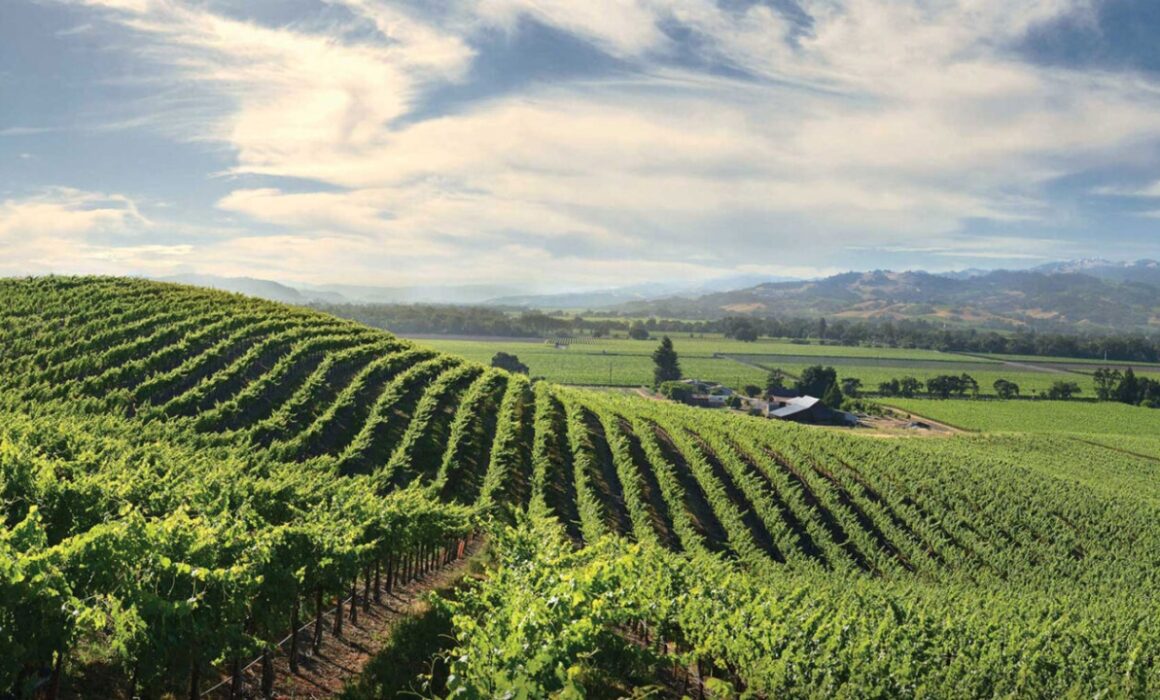More Sonoma County Grand Cru Sites
By Virginie Boone
We’re back to talk about more Sonoma County grand cru-worthy vineyards, sites that grow top-notch grapes and helped build the reputation of Sonoma County as one of the world’s great winegrowing regions. Here they are.
Alexander’s Crown
One of Rodney Strong Vineyards’ iconic sites, Alexander’s Crown sits at 360-feet elevation at the southern end of the Alexander Valley and was first planted in 1971 – half a decade before the Judgment of Paris solidified California Cabernet’s world-class standing – a testament to founder Rod Strong’s good instincts. The first Alexander’s Crown Cabernet Sauvignon was bottled in 1974, becoming Sonoma County’s first single-vineyard Cab. The site is cooled by afternoon winds from the Pacific Ocean. The heart of the site is the top 15 acres of Clone 4 Cabernet in Block 1. Today, the well-drained red volcanic soils support 63 acres of Cab and three of Merlot.
Camp Meeting Ridge
One of the early sites for Pinot Noir and Chardonnay on the Sonoma Coast out above Jenner, Joan and Walt Flowers first planted here in 1991 and the vineyard remains one of Flowers Winery’s essential estate vineyards and a single-vineyard designate. Only two miles from the ocean at 1,500-feet elevation, it sits above the fog, enjoying enough sun for phenolic development while basking in cool temperatures that keep acidity lively and persistent in the wines.
Joan and Walt were nursery owners from Pennsylvania who loved wine and agriculture and had been looking for a way to do both. They bought the 321 acres that would become Flowers Winery in 1989, soon discovering that the “warm site in a cool climate” would be ideal for the grapes they aimed to plant, Pinot and Chardonnay. They bought another 327 acres nearby and planted an additional 43 acres of Pinot Noir in 1998 called Sea View Ridge.
Laurel Glen Vineyard
One of the crown jewels of the Sonoma Mountain appellation, Laurel Glen is planted between 850 and 1,200-feet elevation to Cabernet Sauvignon and faces east above the fog line. The grapes are concentrated and built for aging, getting just enough coolness through the Petaluma Gap to retain acidity for the wines. Planted to Cab since 1968, when the grapes went to Chateau St. Jean and Kenwood’s Artist Series wines, Patrick Campbell bought the property in 1977, taking cuttings from the original three acres of Cab and grafting them onto St. George rootstock to develop the 14 acres it has today. The Laurel Glen clone was thus born, certified as unique by UC Davis.
When Bettina Sichel bought the vineyard and winery in 2011, viticulturalist Phil Coturri took over the farming, changing the trellising from California sprawl to Double Guyot for more even ripening. The vineyard has been CCOF-certified organic since 2014. Since the early days of Campbell, Laurel Glen has always been known as one of California’s most age-worthy wines.
Montecillo Vineyard
With dry-farmed vines of Cabernet Sauvignon on St. George rootstock that date back to 1964, most of Montecillo’s fame came through the time it was owned by Kaarin and Mike Lee of Kenwood Vineyards, who bought it in 2001 from the gentleman who had been selling Montecillo grapes to Kenwood for its Artist Series Cabernet for many years. Mike Lee was Kenwood’s winemaker and one of its founders, along with his father, brother and brother-in-law, John Sheela. Together they bought the Pagani Winery in Kenwood in 1970, evolving it into one of the top Sonoma County wineries of its era. Lee served as winemaker until 2003 and passed away in 2011.
West-facing and up to 1,800-feet in elevation, bordering Sugarloaf State Park, Montecillo has cool mornings and hot afternoons, like much of the Moon Mountain AVA, and rocky, mixed red volcanic soils. With plantings of Cabernet Sauvignon and Zinfandel, vineyard-designates have been made by DuMol, Di Costanza, Turley, Bedrock, Arnot-Roberts, Carlisle, St. Francis and Stewart Cellars. The Guthrie family of Stewart Cellars bought the 51-acre vineyard in 2022, and they produce a beautiful NOMAD Montecillo Vineyard Cabernet from the site.
Richard Dinner Vineyard
Another Sonoma Mountain jewel, Richard Dinner Vineyard is best-known as one of Paul Hobbs Winery’s most distinguished single-vineyard Chardonnays, a site the winemaker has sourced from since 1991. With sun exposure during the day and cooling fog in the morning and evening, it produces grapes of complementary richness and freshness that are also good for aging. Soils are thin, well-draining and volcanic. Other vineyard-designates are made by Croix Estate and Ron Noble.
The vineyard was owned by and is named for the late Richard S. Dinner, who was a philanthropist who served on numerous organization boards and was a member of the Swig family, the founders of Fairmont Hotels. He died in 1998 at the age of 76, survived by his widow Joan.
Image by: Rodney Strong Vineyards


